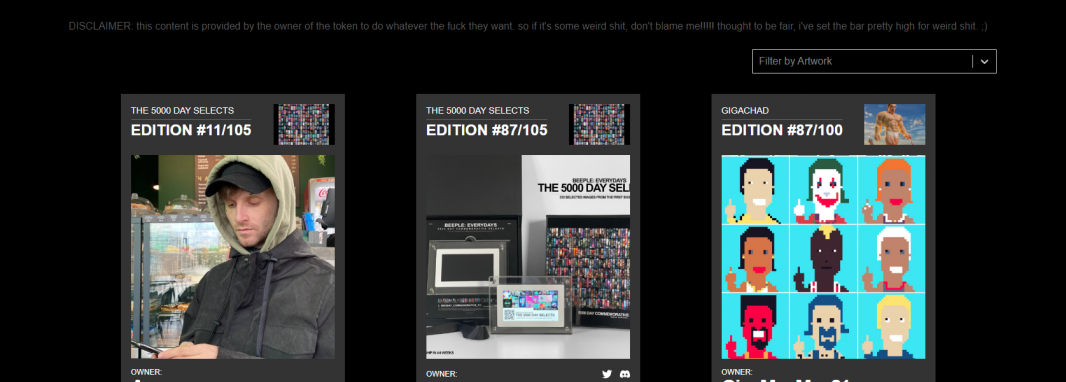If you’ve spent any amount of time in the NFT community in recent years, you’ve probably already heard of Beeple.
It’s essentially the pseudonym of digital artist Mike Winkelman, who’s built himself a reputation as one of the foremost users of NFTs as a release mechanism. His piece Everyday: the First 5000 Days was sold for $69.4 million, making it the fourth most expensive artwork by a living artist. It was also the first purely NFT auction at Christie’s.
We will help you with your NFT project!
More recently, his Human One was sold at auction for just under $29 million at the end of November.
So how can you make successful NFTs and follow in his footsteps? First, let’s take a closer look.
The Basics of Digital Art
Perhaps the most important thing to mention is that Beeple didn’t just appear out of nowhere. He was already a successful digital artist before NFTs became a thing, and it’s a reminder that NFTs aren’t just a free ticket to fame and success. You also need to be good at what you do.
People also remind us that we need to put the hard work in if we want to succeed. He’s been creating a new digital artwork every day since May 2007, including on his wedding day and on the days when his children were born.
But these are the basics of becoming a good digital artist rather than the basics of creating an NFT. You indeed need to be able to create decent nft art collection in the first place, but NFTs are also an option to any copyright holder, meaning that you don’t necessarily need to create the art yourself. Some are even transforming art with AI to build their nft art collection.
Now that we’ve covered the basics of digital art, it’s time to take a closer look at the minting process.
Creating an NFT
The first step to creating an NFT is to generate the artwork. We’re going to assume that you’ve already familiar with NFT. You made art or secured the rights to the piece that you plan to bring to market. You should also ensure that you’re able to prove the provenance of the art along with your ownership, as there’s been a recent spike in the number of fake NFTs that have been brought to market.
After that, it’s time to think about distribution. There are a few different options available to you there, and the first thing to bear in mind is that there are multiple different blockchains to choose from, including Ethereum, Binance Smart Chain, Cosmos and Polkadot. Once you’ve chosen the blockchain, you plan to use, and it becomes challenging to switch to a different one, so spend some time looking into your options before you commit.
Once you’ve selected your blockchain, you have two main options.
The first is to list an existing marketplace. Your choices here will be determined by the blockchain that you selected, but if you go with Ethereum (which is probably the most popular), you’ll be able to choose between OpenSea, Raible and Mintable. After that, you’ll just need an Ethereum wallet that supports NFTs, with popular choices including Coinbase, MetaMask and Trust Wallet.
The alternative is smart contract development and minting. This is a little bit more technical, and so if you’re planning to go with this option, then it’s a good idea to find yourself a development partner who can help you. The good news is that there are many tools out there that are designed to help, with web3 CLI at the front of the market.
The basic process looks like this:
- Set up your environment
- Install the CLI tool
- Set the network
- Deploy
- Mint NFTs
- Transfer NFTs
Even with all of that done, the job isn’t over. Sure, your NFT might have been created and pushed out into the market, but you still need to make sure that people know about it. You’ll want to carry out extensive marketing campaigns to promote your new NFT, but you also need to decide where to direct people.
Yet again, there are two main options for you to choose from. The first is for you to build a marketing site to sell your NFTs, which has the advantage that you’ll maintain total ownership over the site. You can customise it as needed, add any tracks you want, store all of the data you generate and maintain full control over which NFTs are on sale.
But there are downsides to this, too, such as the fact that it’s time-consuming and resource-intensive. You’re also going to have to spend a ton of money driving traffic there.
The other option is to integrate with other marketplaces, which means that you won’t have to worry about development or distribution. But then the problem is that you’ll be putting a lot of time and effort into sending people to a site that’s owned by someone else.
Still, integrating with other marketplaces is the easiest option, and it’s not a bad idea if you’re new to NFTs or you only plan to release one NFT. It’s a lot of work to build a site of your own if you only want to release a single NFT, and people are drawn to existing marketplaces because they know that there will be plenty of NFTs for them to choose from.
Conclusion
Now that you know the basics of creating, minting and marketing NFTs, it’s over to you to get started. Take what you’ve learned today and follow the process through to get your first NFT on the market. Check our article about NFT Metaverse.
We’d love to hear how you get on with NFTs, so please do take the time to come back and share your experience with us in the comments. And, of course, if you’re struggling with it, then you can always reach out to us at Zfort Group NFT Development Company, and we’d be more than happy to help!
We will help you with your NFT project!






